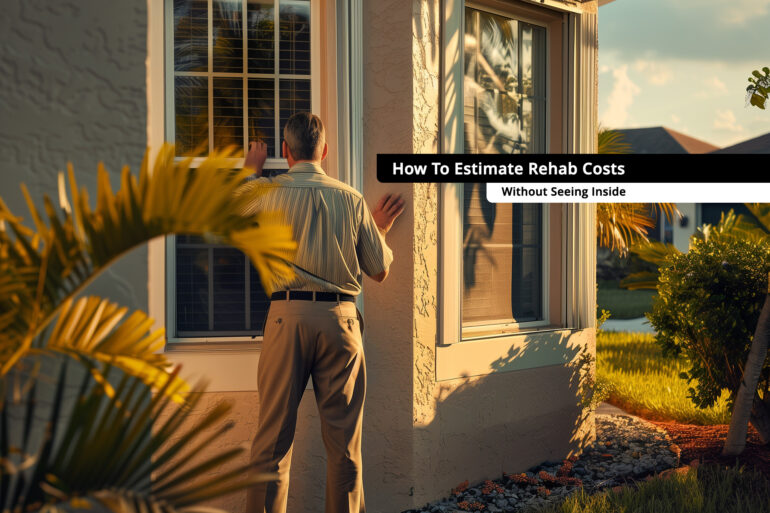How To Estimate Rehab Costs In Real Estate Without Seeing Inside
Estimating property rehab costs has one goal — identifying the potential profit when selling it. There are no standards for renovation projects because the prices vary based on location, material choice, the overall state of the home, and market conditions. Here’s how to project rehab costs without stepping foot inside.
Strategies to Estimate Interior Rehab Costs
How do you estimate the costs if you can’t see the interior? Here are some tips.
Investors guess rehab expenses in either a lump sum or cost per square foot estimates.
Drive by the Property
Inspecting the roofs, walls, windows, and landscape helps determine if you can get an attractive ROI after the rehab. Here are reasons to do it.
To See if It’s Currently Used
Lights turned on during the night strongly indicate someone is residing there. If you buy the property, you must add legal service fees to evict the occupants and wait weeks before starting the renovations.
To Assess the Exterior Damage
From the street, check if there are cracked, curled, or drooping shingles, which are signs of roof damage that require extensive repair. Next, examine if the gutters are clogged or the walls have storm damage. Sometimes, the county may put up a pile of dirt or a burned-down house for an auction. A visual check ensures you don’t waste cash on a failing property.
Once you have an idea of what needs done, you can use our Rehab Cost Estimate Calculator below!
Real Estate Rehab Cost Calculator
Use this calculator to quickly estimate rehab costs for your property investment.
Estimated Rehab Cost:
Breakdown:
Calculator disclaimer: Estimates are based on general averages and may not reflect exact costs for your specific project.
To Check if the Property Has Been Condemned
Drive by the house the night before the auction to ensure the county has not condemned it as dangerous or unsafe or decided to tear it down. Properties like this are sold at a great discount but are usually in extremely rough shape. You may have to demolish the existing structure and rebuild it from scratch.
If you’re an investor who bids in different states, hire somebody living close by and ask them to snap pictures of the exterior and other specific details, like a car in the driveway or powered-on lights. This information can help you evaluate the property’s value.
Do a Title Search
Foreclosed properties have at least one problem. Unreleased liens, encumbrances, conflicting ownership claims, and incorrect information on the documents could prevent you from obtaining title insurance. Do your due diligence in unveiling title flaws because you can’t see these costly issues just driving past the property.
You can search for the title by entering this search string on Google — county + records and deeds website. For instance, “Shelby records and deeds website” will bring up the county’s site where you can do a property record search.
Unless you’re experienced, it’s best to leave the job to the experts to avoid overlooking important details. Hire a closing attorney or a title search company to comb through legal documents and public records to determine who has an ownership claim to the property.
Check With the Building Department
Some renovations on residential properties require building permits. You’d want to know when the last license was pulled for big renovations like the kitchen, bath, or plumbing. If a recent modification has been implemented, the interior may look decent and require minimal change.
Profit is the primary goal of a property rehab, and one way you can maximize the resale value is to focus renovation on areas with high return on investment.
Factors Affecting the Rehab Cost
Investors guess rehab expenses in either a lump sum or cost per square foot estimates. A seasoned flipper uses the lump sum to gauge the price based on their experience and knowledge of the market.
Others use the cost per square foot by listing the scope of work and these factors to come up with a number:
- Price of materials: Costs of interior materials vary in every state and market condition.
- Labor cost: The standard rate for skilled labor differs based on local wage scale and experience.
- Location: Areas with expensive cost of living will demand higher repair budgets.
- Project timeline: Expect to pay more for urgent projects.
- The average cost to flip a home is $47,903, which can still increase or decrease depending on various factors. Before you start a rehab project, ensure you have sufficient financing to cover all expenses.
Calculate Rehab Cost per Square Foot
The scope of rehab work for the interior may include the following components:
- Flooring
- Paint
- Roof
- Electrical and lighting
- Plumbing
- HVAC
- Bathroom and fixtures
- Pest control
- Kitchen and appliances
- Walls
- Doors
- Windows
Vinyl flooring can cost between $2 and $7 per square foot on average. Therefore, a replacement for a 1,000-square-foot home will rack up $7,000 at most. Investors pay an average of $2,565 for rehab.
Fresh paint costs an average of $2 to $6 per square foot. A DIY interior painting project will cost between $200 and $300. Hiring a professional will set you back a few hundred dollars more, which is well worth it unless you’re a seasoned painter.
The average roof replacement cost varies depending on the material. Basic asphalt shingles cost $3.50 to $5.50 apiece, amounting to project costs starting at $5,000. If you have a bigger budget, opt for higher-quality materials that last longer and cost between $8,000 and $15,000. Renovating with premium materials, like slate and metal, will set you back $25,000 and up.
Window replacement costs about $234-$1,224 per window. Vinyl and aluminum materials are affordable, but fiberglass and wood can increase the rehab estimate further.
The numbers aren’t fixed and can change depending on your location, the cost of materials in that region, labor cost scale, and market condition. It’s best to ask a local investor or contractor for an approximate expenditure.
Work with a local contractor or investor to know the numbers.
Prioritize Cost-Effective Upgrades
Profit is the primary goal of a property rehab, and one way you can maximize the resale value is to focus renovation on areas with high return on investment.
Kitchen
The kitchen is often the highlight of any property, so modifications can make a big impact. You can install a coffee bar, repaint the cabinets, and hang open shelves. These are minor additions that can appreciate the after-repair value.
Bathroom
Another focal point in any residence is the bathroom. A midrange remodel will return 66.7% of the average cost of $24,606, while an upscale modification costing roughly $76,827 can add 36.7% more to the resale value. Aim for these overhauls. Some bathroom furnishings to consider are upgrading to a walk-in shower, refinishing a bathtub, retiling the surround, replacing the flooring, and adding more lighting.
Bedroom
Upgrades in this area don’t require much investment, but they add appeal to the property and increase its worth. Add statement lighting to make the room stand out. Other simple modifications are repainting the wall, creating a seating area, changing the flooring, and installing vertical storage. These projects can increase the function and style of the bedroom and make it look cozy.
Get a Good Estimate by Knowing the Local Costs
Work with a local contractor or investor to know the numbers. Choose affordable remodels that drive the resale value up to maximize your profits. This can include repainting floors and replacing roofs. Finally, focus on the kitchen, bedroom, and bathroom, as these are focal spaces in the home. These projects will pay for themselves once you sell the property.








